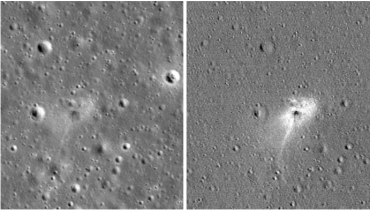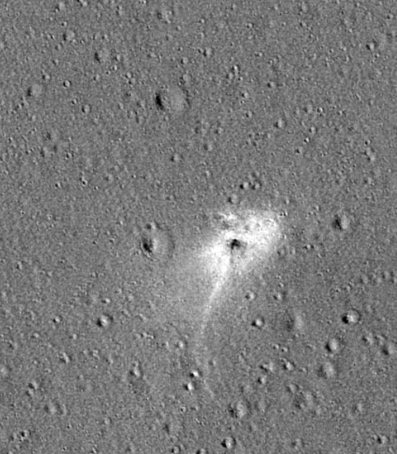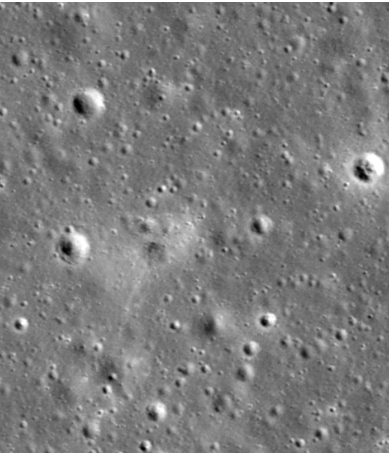click here for video
https://www.kulr8.com/news/national...deo_f4524821-b4f8-51a5-a1ca-66930521d127.html
First privately-funded moon mission ends in crash
First privately-funded moon mission ends in crash
CNN
Israel's Beresheet, the first privately-funded mission to the moon, crashed on the lunar surface. The spacecraft aimed to perform a soft landing on the moon and would have made Israel the fourth country to do so.
Published at: 4:38 AM, Sat May 18 2019
Israel's Beresheet, the first privately-funded mission to the moon, crashed on the lunar surface. The spacecraft aimed to perform a soft landing on the moon and would have made Israel the fourth country to do so.
TownNews.com Content Exchange
Tags
https://www.cnet.com/news/nasa-spots-site-of-israels-heartbreaking-moon-lander-crash/
Sci-Tech Leer en español NASA spots site of Israel's heartbreaking moon lander crash
Beresheet left a mark on the moon.
May 15, 2019 9:51 AM PDT
Before and after images of Beresheet's crash site.
NASA/GSFC/Arizona State University
It was so close. Israeli nonprofit SpaceIL very nearly landed its Beresheet spacecraft on the surface of the moon earlier this year, but an engine glitch on the way down doomed the mission to a crash landing. NASA's Lunar Reconnaissance Orbiter (LRO) has found the lander's final resting place.
The LRO camera team shared images of the crash site on Wednesday, with before and after shots that show the blast mark Beresheet left in the Sea of Serenity on the lunar surface.
 Enlarge Image
Enlarge Image
These images show the Beresheet crash site as seen by NASA's LRO. The image on the right is processed to highlight changes near the landing site.
NASA/GSFC/Arizona State University
The dark smudge Beresheet left behind is about 33 feet (10 meters) wide. A lighter halo surrounds it.
LRO's orbit put it into position to snap the area on April 22 at a distance of 56 miles (90 kilometers) above the moon's surface.
"From so far away, LROC could not detect whether Beresheet formed a surface crater upon impact. It's possible the crater is just too small to show up in photos," NASA said. The agency said it's also possible the spacecraft left a small indentation rather than a crater.
Beresheet still made history
SpaceIL achieved the first moon orbit by a privately funded spacecraft, but it intends to stick the landing next time.

Cosmic dead ringers: 27 super strange-looking space objects
27 Photos
Share your voice
Comments
Tags
Sci-Tech NASA Space
https://futurism.com/the-byte/nasa-impact-israel-crashed-moon-lander
May 16th 19__Dan Robitzski__Filed Under: Off World
Found Footage
Last month, Israel’s SpaceIL very nearly became the first private company to land a spacecraft on the Moon. Unfortunately, Beresheet — that’s the lunar lander — suffered a last-minute engine failure and crashed.
Now, CNET reports that NASA managed to snap a photo of the crash site using the camera on its Lunar Reconnaissance Orbiter (LRO) and has begun to study the impact, which could potentially help the space agency track down missing equipment that Beresheet was carrying to the Moon.
Aftermath
At 56 miles above the lunar surface, the LRO was too far away to tell how deep of a crater Beresheet left, according to CNET. But it did reveal that the Israeli spacecraft left a 33-foot-long impact on the Moon’s surface when it crashed.
“From so far away, LROC could not detect whether Beresheet formed a surface crater upon impact. It’s possible the crater is just too small to show up in photos,” reads a NASA press release.
According to the release, it’s possible that Beresheet simply left a small dent in the surface of the Moon instead of carving out a crater, but NASA won’t know for sure until it takes a closer look.
READ MORE: NASA spots site of Israel’s heartbreaking moon lander crash [CNET]
More on Beresheet: After Failed Moon Landing, Israel Vows to Try Again
PEER REVIEWED CONTENT FROM PARTNERS WE LOVE
Powered by
Crime Scene Photography
NASA Found The Impact From Israel’s Crashed Moon Lander

NASA
https://edition.cnn.com/2019/05/17/world/beresheet-moon-impact-site-scn/index.html
This is where the Israeli spacecraft crashed into the moon

By Ashley Strickland, CNN
Updated 2114 GMT (0514 HKT) May 17, 2019
(CNN)On April 11, the Israeli Beresheet spacecraft attempted to land on the moon in the ancient volcanic field called the Sea of Serenity -- but it crashed instead. Now, NASA has released images that helped researchers discover the crash site.
NASA's Lunar Reconnaissance Orbiter, which has been orbiting for a decade, passed over the landing site April 22 and took images.
The photos, taken from 56 miles above the surface, feature a telling smudge 32.8 feet wide. There's a halo of lighter, more reflective material around the dark smudge, suggesting that the soil around the landing site smoothed out as it was blown away, the agency said.
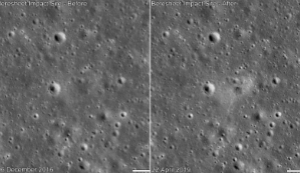
This is a before and after comparison of the landing site, with the right side showing the aftermath.
It's not known whether the impact created a crater on the lunar surface. If there is one, it isn't visible in the photos, but that could be due to the distance. It's also possible that the impact formed only an indent, rather than a crater, because the spacecraft was lightweight and had a low velocity and a low approach angle, compared with a dense meteoroid of similar size.
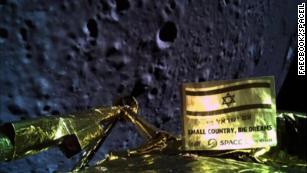
A technical glitch led to Israeli spacecraft crash, company says
The moon is impacted by material from space all the time, leaving craters behind. When the orbiter passes over the area again Sunday, it will record more images to look for a crater.
Beresheet was privately funded by nonprofit SpaceIL. Things went well during the descent, but then officials on Earth lost contact with the spacecraft.
After the crash, the company behind the $100 million spacecraft said its engineers believe that a technical glitch caused the main engine to shut down and later "made it impossible to slow the spacecraft's descent."
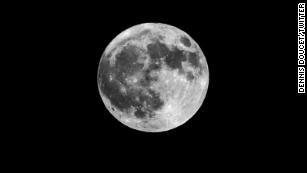
NASA plans to land the first woman on the moon by 2024
The spacecraft's first technical issue occurred at 14 kilometers (about 8.7 miles) above the moon, SpaceIL officials said. Beresheet then lost communications with the control room in Israel during the landing sequence.
Engineers were able to restart communications with the spacecraft, but officials said it was too late; it was moving too fast to land properly.
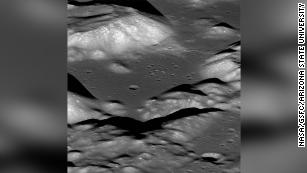
Earth's moon is shrinking and quaking, study says
Beresheet was the first privately funded moon mission. Its name was a reference to the first words of the Bible in Hebrew, which translates to "In the beginning."
The spacecraft was launched in February and went on a seven-week journey to reach the moon. It circled the Earth multiple times before being "slingshotted" to the moon, traveling about 4 million miles in the process.
If the Israeli team had been successful, it would have been the first private enterprise to make a controlled moon landing, with the smallest spacecraft and the smallest budget.
CNN's Nicole Chavez and Samantha Beech contributed to this report.
https://www.kulr8.com/news/national...deo_f4524821-b4f8-51a5-a1ca-66930521d127.html
First privately-funded moon mission ends in crash
- 15 hrs ago
First privately-funded moon mission ends in crash
CNN
Israel's Beresheet, the first privately-funded mission to the moon, crashed on the lunar surface. The spacecraft aimed to perform a soft landing on the moon and would have made Israel the fourth country to do so.
Published at: 4:38 AM, Sat May 18 2019
Israel's Beresheet, the first privately-funded mission to the moon, crashed on the lunar surface. The spacecraft aimed to perform a soft landing on the moon and would have made Israel the fourth country to do so.
TownNews.com Content Exchange
Tags
https://www.cnet.com/news/nasa-spots-site-of-israels-heartbreaking-moon-lander-crash/
Sci-Tech Leer en español NASA spots site of Israel's heartbreaking moon lander crash
Beresheet left a mark on the moon.
May 15, 2019 9:51 AM PDT
Before and after images of Beresheet's crash site.
NASA/GSFC/Arizona State University
It was so close. Israeli nonprofit SpaceIL very nearly landed its Beresheet spacecraft on the surface of the moon earlier this year, but an engine glitch on the way down doomed the mission to a crash landing. NASA's Lunar Reconnaissance Orbiter (LRO) has found the lander's final resting place.
The LRO camera team shared images of the crash site on Wednesday, with before and after shots that show the blast mark Beresheet left in the Sea of Serenity on the lunar surface.
These images show the Beresheet crash site as seen by NASA's LRO. The image on the right is processed to highlight changes near the landing site.
NASA/GSFC/Arizona State University
The dark smudge Beresheet left behind is about 33 feet (10 meters) wide. A lighter halo surrounds it.
LRO's orbit put it into position to snap the area on April 22 at a distance of 56 miles (90 kilometers) above the moon's surface.
"From so far away, LROC could not detect whether Beresheet formed a surface crater upon impact. It's possible the crater is just too small to show up in photos," NASA said. The agency said it's also possible the spacecraft left a small indentation rather than a crater.
Beresheet still made history
- Israel's Beresheet moon landing attempt ends with a crash
- Israel's moon dream lives on with second lunar lander Beresheet 2
SpaceIL achieved the first moon orbit by a privately funded spacecraft, but it intends to stick the landing next time.

Cosmic dead ringers: 27 super strange-looking space objects
27 Photos
Share your voice
Comments
Tags
Sci-Tech NASA Space
https://futurism.com/the-byte/nasa-impact-israel-crashed-moon-lander
May 16th 19__Dan Robitzski__Filed Under: Off World
Found Footage
Last month, Israel’s SpaceIL very nearly became the first private company to land a spacecraft on the Moon. Unfortunately, Beresheet — that’s the lunar lander — suffered a last-minute engine failure and crashed.
Now, CNET reports that NASA managed to snap a photo of the crash site using the camera on its Lunar Reconnaissance Orbiter (LRO) and has begun to study the impact, which could potentially help the space agency track down missing equipment that Beresheet was carrying to the Moon.
Aftermath
At 56 miles above the lunar surface, the LRO was too far away to tell how deep of a crater Beresheet left, according to CNET. But it did reveal that the Israeli spacecraft left a 33-foot-long impact on the Moon’s surface when it crashed.
“From so far away, LROC could not detect whether Beresheet formed a surface crater upon impact. It’s possible the crater is just too small to show up in photos,” reads a NASA press release.
According to the release, it’s possible that Beresheet simply left a small dent in the surface of the Moon instead of carving out a crater, but NASA won’t know for sure until it takes a closer look.
READ MORE: NASA spots site of Israel’s heartbreaking moon lander crash [CNET]
More on Beresheet: After Failed Moon Landing, Israel Vows to Try Again
PEER REVIEWED CONTENT FROM PARTNERS WE LOVE
- Individualize vaccination recommendations in alignment with current guidelines to help mitigate the risk of vaccine-preventable infection in patients with IBD
Gary R. Lichtenstein, MD, myCME, 2018 - Diagnose interstitial lung diseases in a timely manner through optimal use of diagnostic criteria and radiologic findings
myCME, 2018
- Vaccines: drone drop-offs improve access in poor countries
Haidari LA et. al.., Univadis - Identify gender-specific treatment needs when addressing substance use disorders.
Mark S. Gold, MD, myCME, 2018
Powered by
Crime Scene Photography
NASA Found The Impact From Israel’s Crashed Moon Lander

NASA
https://edition.cnn.com/2019/05/17/world/beresheet-moon-impact-site-scn/index.html
This is where the Israeli spacecraft crashed into the moon

By Ashley Strickland, CNN
Updated 2114 GMT (0514 HKT) May 17, 2019
(CNN)On April 11, the Israeli Beresheet spacecraft attempted to land on the moon in the ancient volcanic field called the Sea of Serenity -- but it crashed instead. Now, NASA has released images that helped researchers discover the crash site.
NASA's Lunar Reconnaissance Orbiter, which has been orbiting for a decade, passed over the landing site April 22 and took images.
The photos, taken from 56 miles above the surface, feature a telling smudge 32.8 feet wide. There's a halo of lighter, more reflective material around the dark smudge, suggesting that the soil around the landing site smoothed out as it was blown away, the agency said.

This is a before and after comparison of the landing site, with the right side showing the aftermath.
It's not known whether the impact created a crater on the lunar surface. If there is one, it isn't visible in the photos, but that could be due to the distance. It's also possible that the impact formed only an indent, rather than a crater, because the spacecraft was lightweight and had a low velocity and a low approach angle, compared with a dense meteoroid of similar size.

A technical glitch led to Israeli spacecraft crash, company says
The moon is impacted by material from space all the time, leaving craters behind. When the orbiter passes over the area again Sunday, it will record more images to look for a crater.
Beresheet was privately funded by nonprofit SpaceIL. Things went well during the descent, but then officials on Earth lost contact with the spacecraft.
After the crash, the company behind the $100 million spacecraft said its engineers believe that a technical glitch caused the main engine to shut down and later "made it impossible to slow the spacecraft's descent."

NASA plans to land the first woman on the moon by 2024
The spacecraft's first technical issue occurred at 14 kilometers (about 8.7 miles) above the moon, SpaceIL officials said. Beresheet then lost communications with the control room in Israel during the landing sequence.
Engineers were able to restart communications with the spacecraft, but officials said it was too late; it was moving too fast to land properly.

Earth's moon is shrinking and quaking, study says
Beresheet was the first privately funded moon mission. Its name was a reference to the first words of the Bible in Hebrew, which translates to "In the beginning."
The spacecraft was launched in February and went on a seven-week journey to reach the moon. It circled the Earth multiple times before being "slingshotted" to the moon, traveling about 4 million miles in the process.
If the Israeli team had been successful, it would have been the first private enterprise to make a controlled moon landing, with the smallest spacecraft and the smallest budget.
CNN's Nicole Chavez and Samantha Beech contributed to this report.
- https://www.space.com/beresheet-moon-lander-crash-site-photos.html
- Moon Crash Site Found! NASA Probe Spots Grave of Israeli Lunar Lander
By Elizabeth Howell 2019-05-15T20:38:47Z Spaceflight
Shares
A sharp-eyed NASA spacecraft spotted the probable remains of an Israeli spacecraft that crash-landed on the moon last month.
New lunar images show what appears to be the final resting place of the Beresheet lander, a spacecraft managed by nonprofit organization SpaceIL.
Beresheet's impact site appears as a "white impact halo" in the new image from the Lunar Reconnaissance Orbiter (LRO), NASA officials said in a statement. A white tail is also clearly visible in the image, which NASA said is consistent with Beresheet's trajectory and approach angle as the spacecraft came down April 11.
Related: This Is the Last Photo Israel's Beresheet Moon Lander Ever Took
NASA's Lunar Reconnaissance Orbiter spotted the crash site of SpaceIL's Beresheet spacecraft, which failed during a moon landing April 11, 2019.
(Image: © NASA/GSFC/Arizona State University)
"The cameras captured a dark smudge, about 10 meters [32 feet] wide, that indicates the point of impact. The dark tone suggests a surface roughened by the hard landing, which is less reflective than a clean, smooth surface," NASA officials said.
"The light halo around the smudge could have formed from gas associated with the impact or from fine soil particles blown outward during Beresheet's descent, which smoothed out the soil around the landing site, making it highly reflective," the agency added.
Related: The Greatest Moon Crashes of All Time
The mission of Beresheet, the first private lunar lander, came to a sudden end on April 11 during its descent to the lunar surface. LRO's orbit first brought that spacecraft over the impact site on April 22, and the orbiter captured the image using its black-and-white, narrow-angle cameras.
LRO flew over the site at an altitude of about 56 miles (90 kilometers). From that distance, the spacecraft could not detect any crater. NASA officials said it's possible the crater was too small for LRO's cameras or that Beresheet created a small indent instead of a crater.
Beresheet hit the surface at a low angle of approach (8.4 degrees relative to the surface) and with a relatively low velocity and light mass compared to a typical meteoroid (space rock) that slams into the moon's surface, NASA officials noted. All of these conditions may have added up to a small indent on the surface.
NASA found the site thanks to radio tracking of Beresheet's descent, which pinpointed the landing site to an uncertainty of only a few miles. Technicians compared new images to 11 "before" images taken of the area and found only one feature that plausibly could have been made by Beresheet. The team also compared the site to craters that were made by other spacecraft that hit the lunar surface, including GRAIL, LADEE and Ranger.
NASA isn't done with its Beresheet observations yet. Small mirrors were mounted on the top of the spacecraft, so the agency is trying to bounce laser pulses from LRO onto the mirrors. It's not clear yet if the retroreflector survived the crash.- Did NASA Experiment Survive Israeli Moon Lander's Crash?
- Space Is Hard, Beresheet Israeli Lunar Crash Proves Again
- Manual Command Likely Caused Israeli Moon Lander's Crash
Have a news tip, correction or comment? Let us know at co
Attachments
-
 1558182173277.gif57 bytes · Views: 156
1558182173277.gif57 bytes · Views: 156 -
 1558182173322.gif57 bytes · Views: 162
1558182173322.gif57 bytes · Views: 162 -
 1558182173359.gif57 bytes · Views: 153
1558182173359.gif57 bytes · Views: 153 -
 1558182173392.gif57 bytes · Views: 160
1558182173392.gif57 bytes · Views: 160 -
 1558182173233.gif57 bytes · Views: 159
1558182173233.gif57 bytes · Views: 159 -
 1558182173460.gif57 bytes · Views: 141
1558182173460.gif57 bytes · Views: 141 -
 1558182173493.gif57 bytes · Views: 167
1558182173493.gif57 bytes · Views: 167 -
 1558182173589.gif57 bytes · Views: 148
1558182173589.gif57 bytes · Views: 148 -
 1558182173527.gif57 bytes · Views: 154
1558182173527.gif57 bytes · Views: 154 -
 1558182173556.gif57 bytes · Views: 148
1558182173556.gif57 bytes · Views: 148 -
 1558182173761.gif57 bytes · Views: 152
1558182173761.gif57 bytes · Views: 152 -
 1558182173681.gif57 bytes · Views: 166
1558182173681.gif57 bytes · Views: 166 -
 1558182173657.gif57 bytes · Views: 151
1558182173657.gif57 bytes · Views: 151 -
 1558182173787.gif57 bytes · Views: 148
1558182173787.gif57 bytes · Views: 148 -
 1558182173708.gif57 bytes · Views: 142
1558182173708.gif57 bytes · Views: 142 -
 1558182173627.gif57 bytes · Views: 149
1558182173627.gif57 bytes · Views: 149 -
 1558182173429.gif57 bytes · Views: 154
1558182173429.gif57 bytes · Views: 154 -
 1558182173736.gif57 bytes · Views: 161
1558182173736.gif57 bytes · Views: 161



